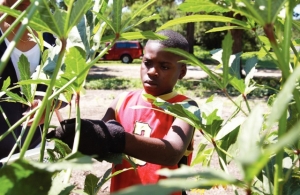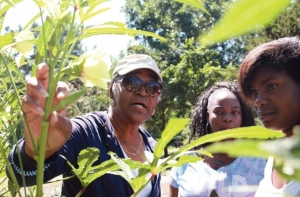Shared crop
By From staff reports
Published in News on July 30, 2014 1:46 PM

News-Argus/MELISSA KEY
Wilvens Idioris, 11, cuts off some okra from a plant at the community garden managed by the Little Washington Growing Group on Tuesday morning. Wilvens came to the garden as part of the Prevention and Treatment Center's summer program.

News-Argus/MELISSA KEY
Cheryl Alston, head of the Little Washington Growing Group Garden, teaches Bryanna Crawford, 15, and Masani Winslow, 13.
When you don't have a lot of money in your household budget, fresh foods can be out of reach. And it is even tougher if you have trouble getting to the grocery store.
According to federal designations, when an area has high poverty and at least 33 percent of residents live at least one mile from the grocery store, it is classified as a food desert.
In Goldsboro, that is the area south of Ash Street from Stoney Creek west.
Food deserts can also occur in rural areas, although the mileage changes -- 10 miles to nearest grocery stores.
Limited access to fresh foods can result in obesity, diabetes and other ailments.
A state committee formed to deal with the issue doesn't want the government to solve the problem. Its members want communities to solve the problem themselves.
In Wayne County, that task falls to Cheryl Alston, a retired Goldsboro High School science teacher, who leads the Wayne Food Initiative, a collaborative community effort to build a system to provide healthy foods and extra income through community gardening.
And that effort begins with a bit of earth.
Ms. Alston and the volunteers tend a nearly 3.5-acre plot of land off U.S. 117. Over the last five years, that plot has become a diverse growing space, with lots of fresh vegetables to choose.
This year, weather conditions have made gardening a little challenging.
"I'm so glad to see the lima beans come up," Ms. Alston said.
The plot began in the Washington Park area of town with almost two acres of city land, but has expanded to its present size over the last few years.
Compost comes from the city composting facility at no cost.
The idea is shared work and shared gain, Ms. Alston said.
A family can tend two rows of crops and trade produce with other families in the garden.
"We'll give five families two rows each, and they can grow whatever they want," Ms. Alston said. "Then they can trade with the other families and get what they want. Hopefully they'll have some left over to sell, too."
There is no cost to participants -- and Ms. Alston hopes there will be room for more in the future.
"We'll go to 10 families and then 20 families and then up," Ms. Alston said.
As part of the project, each family is required to recruit another family to tend two rows as well.
"I have the rows ready, the tools and the seeds," she said. "All they have to do is come tend to it."
Ms. Alston hopes to develop a market on site at the cooperative garden so that produce can be sold, essentially, right out of the field.
She also plans to employ area teenagers to tend the garden to get them involved in gardening and providing good, fresh food.
Currently in Wayne County, Project SWARM, Students Working for an Agricultural Revolutionary Movement, works to provide teenagers with a chance to learn more about providing healthy foods for themselves as well.
Ms. Alston said she hopes to see the growing garden develop into an urban farm over time.
"The Washington Park Community Farm," she said. "People still hold this area in their hearts. People lived down here and this was a park that always flooded. People loved living here and they will enjoy gardening here."
For more information on the farming program, call Ms. Alston at 919-270-7262.
